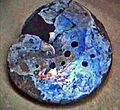Mosasaur facts for kids
Quick facts for kids MosasaursTemporal range: Upper Cretaceous
|
|
|---|---|
 |
|
| Mosasaurus hoffmanii | |
| Scientific classification | |
| Class: | |
| Superorder: | |
| Order: | |
| Suborder: | |
| Family: |
Mosasauridae
|
| Genus: |
Mosasaurus
Conybeare 1822
|
Mosasaurs were huge, meat-eating ocean lizards that lived during the Upper Cretaceous period. This was a time when dinosaurs still roamed the Earth! The very first fossil of a Mosasaur, called Mosasaurus hoffmanni, was found in the Netherlands in 1776. It was given its name in 1822.
Contents
Where Did Mosasaurs Live?
Mosasaurs breathed air, just like us. They were amazing swimmers and perfectly suited for the warm, shallow seas of the Upper Cretaceous. These ancient seas were often found over continents, not just deep oceans. Mosasaurs were so good at living in the water that they gave birth to live babies. They did not need to go back to shore to lay eggs, unlike sea turtles today.
Thousands of Mosasaur fossils have been discovered. They have been found on every continent! There are about 40 different types, or species, of Mosasaurs known so far. Many skeletons have been found in North America. These were found in chalk deposits from an ancient sea called the Western Interior Seaway.
It's interesting to know that other large marine reptiles, like ichthyosaurs, had died out before Mosasaurs became common. Also, plesiosaurs and sea-going crocodiles were becoming less common. Scientists are not sure why this happened. Maybe there were more large predator fish competing for food. Mosasaurs seemed to take over the role of the top ocean predators. They thrived in the later Cretaceous period. However, they became extinct during the big event that also wiped out the dinosaurs. This event is known as the K/T extinction event.
How Big Were Mosasaurs?
The first Mosasaur found was estimated to be about 33 feet (10 meters) long. Imagine a creature as long as a school bus! Mosasaurus had four paddle-like flippers. These were attached to a long, sleek body with a powerful tail. Their huge heads had massive jaws, up to 4 feet (1.2 meters) long, filled with many sharp teeth.
Their jaws could open very wide, about 3 feet (1 meter). The lower jaw was loosely connected to the skull with a special joint on each side. This loose joint allowed them to swallow very large prey whole! They hunted many different sea creatures. Their diet included fish, turtles, molluscs, and shellfish. Scientists have even found ammonite fossils with Mosasaur tooth marks on them.
The smallest Mosasaur known was Carinodens belgicus. It was about 10 to 11.5 feet (3.0 to 3.5 meters) long. This smaller Mosasaur probably lived in shallow waters near the coast. It used its round, strong teeth to crush molluscs and sea urchins. Most Mosasaurs were much larger. They could grow up to 56 feet (17 meters) long! The record for the longest Mosasaur goes to Hainosaurus, which was an incredible 57.4 feet (17.5 meters) long.
Different Kinds of Mosasaurs
Many other types of Mosasaurs have been discovered since the first one. One example is Tylosaurus. Another type, Mosasaurus maximus, was found in Texas. All Mosasaurs shared a similar body shape and way of life. However, some, like Prognathodon, had special crushing teeth. These teeth were perfect for breaking open shellfish. Scientists believe that the closest living relatives of Mosasaurs today are the monitor lizards.
Images for kids
-
A fossil shell of an ammonite showing bite marks from a mosasaur. This is at the Peabody Museum of Natural History.
-
A fossil jaw piece from a mosasaur found in the Czech Republic.
-
A picture of a tylosaurine, Tylosaurus pembinensis.
See also
 In Spanish: Mosasaurios para niños
In Spanish: Mosasaurios para niños













